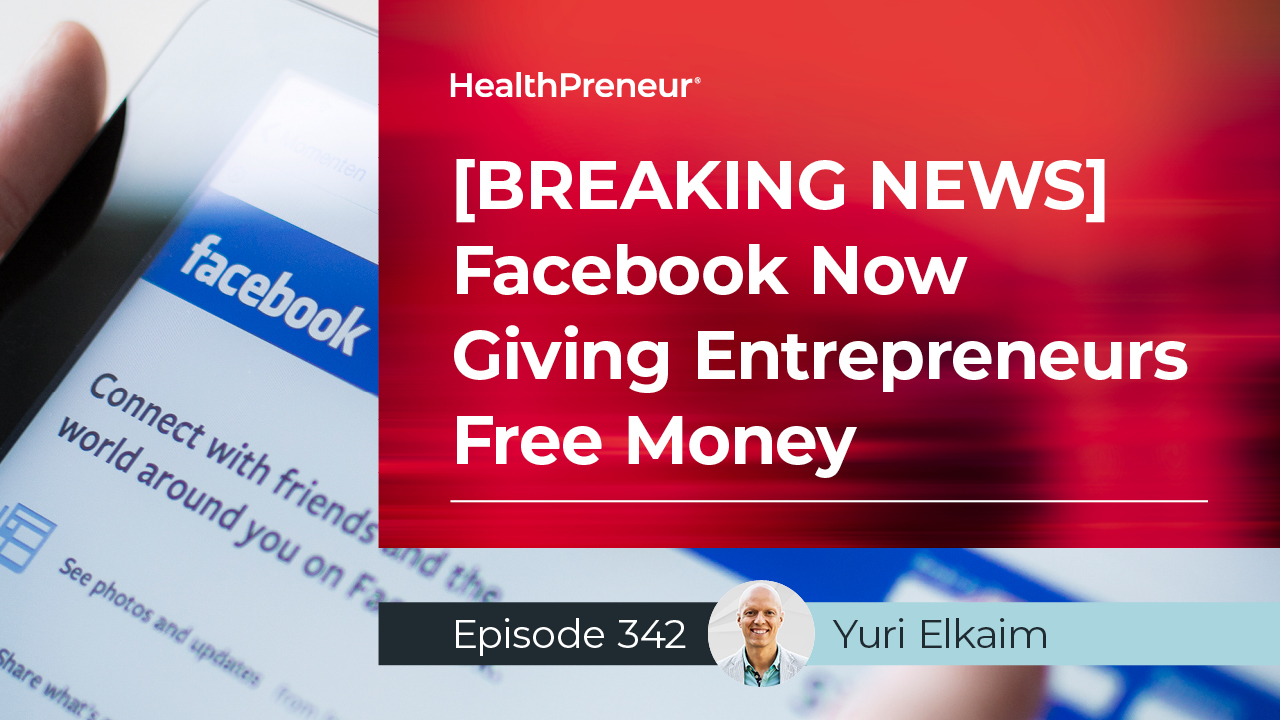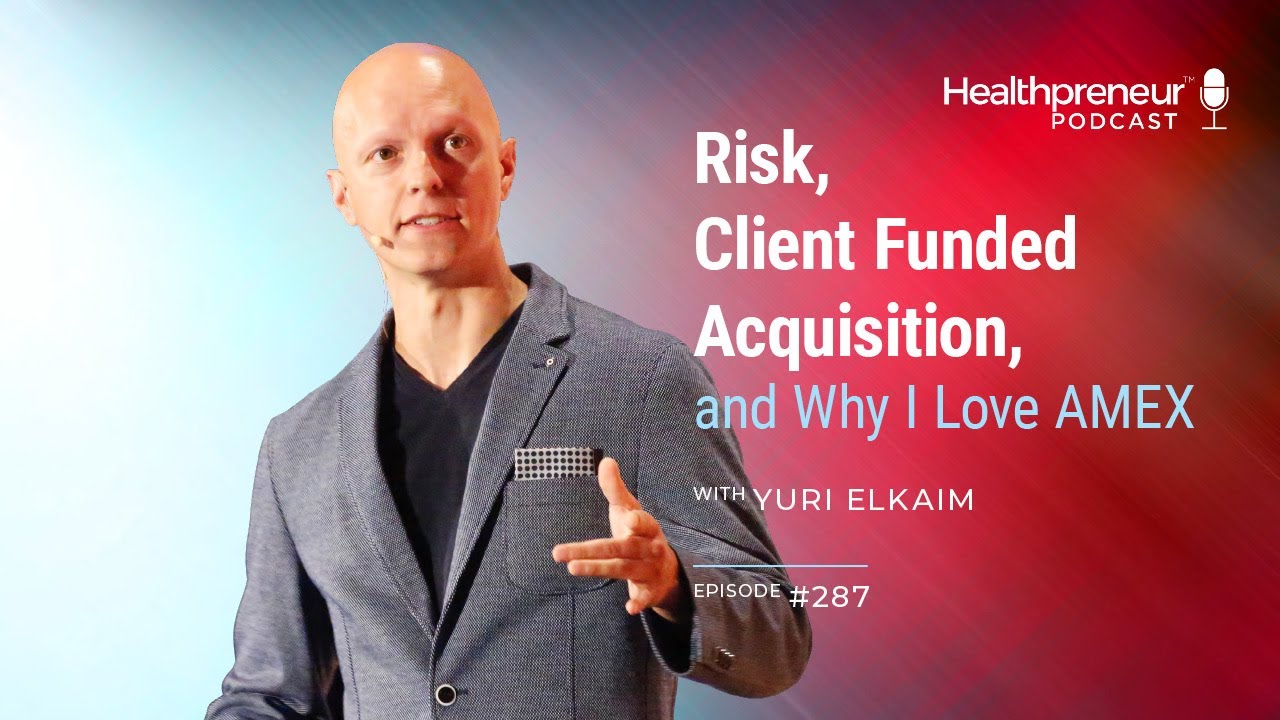Innovating vs Imitating

What’s up Healthpreneurs? It’s time for another episode of the Healthpreneur podcast! Today we’re talking about innovation versus imitation. Why is this important? Because if you aren’t a thought-leader, you’re a thought-repeater. Which do you prefer?
It’s no secret: Go on social media and you’ll see that there are thousands of people doing exactly what you do. And if you want to be heard above the noise, you’ve GOT to stand out. You’ve got to start making moves NOW that’ll keep you at the forefront of the industry for years to come.
I’ve got a couple simple pointers to get you started on the path to thought leadership. Whatever your business, chances are you can apply these ideas to stand out and innovate something new. Tune in to find out!
In This Episode I discuss:
01:00 – 04:30 – Introducing today’s topic: Innovation versus imitation
04:30 – 11:30 – Innovation through imitation; be inspired but then improve upon what you see
11:30 –19:00 – Start with quotes
19:00 – 22:00 – How to learn from others and apply these ideas to your own business
22:00 – 26:00 – Some final words about thought leadership
Transcription
How’s it going? Welcome back to the Healthpreneur Podcast. Yuri with you once again. I mean, who else is going to be here other than me? Today is going to be a really great episode. I say that all the time, but I think each episode gets better. I mean, maybe, maybe not, right?
Introducing today’s topic: Innovation versus imitation
Today we’re talking about innovation versus imitation. This is a really big concept, especially if you want to be a thought leader. I think everyone should become a thought leader because if you’re not a thought leader, then you’re essentially a thought repeater. If you want to stand out in this competitive space, and when I say this competitive space I really mean the health and wellness industry, there is no shortage of ads.
I mean, I look at my feed. It’s hilarious how many ads there are for other people talking about how to build your fitness business. It’s almost overwhelming. Then you just scroll through the feeds, and there’s thousands of other people doing what we do, doing what I do, doing what you do. So how do you stand out?
Well, number one is if you don’t get this right, you’re going to end up being caught up in the shuffle. You’re going to be one of the many who are just kind of treading along not really standing out. But if you do get this right and you do this consistently, what ends up happening is that this builds the foundation for longevity, and longevity is one of the fastest, well, ironically one of the best ways and maybe fastest ways, to stand out in the long-term, if that even makes sense.
So when I talk about innovation versus imitation, there is no shortage of people who rip off other people’s IP, right? So you have a great idea. You put together some kind of thing, and then you find out that someone rips it off and does their thing.
So, for instance, there was a dude, a chiropractor, who has a company called the Health Business Accelerator, and he has a Facebook page called that. I sent him a cease and desist. I said, “Hey, dude, we own the trademark for this. We’ve been using this for years. I might appreciate if you take it down. I’d rather not get the lawyers involved. I’d rather not get the lawyers involved and just wanted to give you a friendly heads-up.” I’m just going to fix my mic here.
He’s like, “Cool, man. Thanks for letting me know. I’ve taken that down.” That was done, right? So I don’t know if his website’s down, but the Facebook page is down. But we’ll talk about the website another time. Anyways, the thing is your intellectual property is your intellectual property. You really need to think about what goes into creating it, and then you really want to protect that.
Now, I’m not saying you have to surround yourself with lawyers and sue people. That’s not what this is about. But a thought leader is somebody who comes up with ideas and ways of looking at the world which are unique from what everyone else is talking about. For instance, I don’t believe there really is anything new that is being created, right? There’s nothing really … I mean, there might be, but for the most part, we’re not reinventing the wheel. We’re not inventing brand new things out of thin air.
Innovation through imitation; be inspired but then improve upon what you see
What we’re typically doing is we’re looking at how things are, and we’re thinking to ourselves, “How can I make this better?” So I believe that true innovation is very tough for most people. That doesn’t mean that you’re not innovating. I believe that you should actually innovate through imitation. So let me give you an example of what I mean. I’m actually going to share two ways for you to generate some really cool ideas, too, okay?
So the first way, which is going to segue into what I’m talking about, the first way to generate great ideas is to think about “yes but” or “yes and.” So think about this. A student sees an idea or some type of concept, and they’re like, “That’s a great idea.” A teacher says, “That’s a great idea. How do I share that?” A thought leader says, “That’s a great idea. What do I think about that?” If you think of where you’re at on that spectrum, it should really be clear as day.
So typically I will think about, for myself, I’m probably going to be in the teacher and the thought leader, those two categories. I try to be more in the thought leader category because I don’t want to just repeat stuff. I believe, listen, according to what I just showed you, if you’re a teacher you’re essentially a thought repeater. You’re just sharing what other people said.
A really easy way for me to look at this is if I go to your Facebook page or your Facebook profile and all you’ve done is post other people’s stuff, then you are a thought repeater. There’s no reason for me to be like, “Man, this person’s really put some thought into this. That’s really powerful.” Oh, they’re just kind of sharing other cool stuff that they found, which is fine. But if you really want to stand out, now you want to be the preeminent, dominant figure in your space, you have to become a thought leader.
In order to be a thought leader, you have to look at what is, and you have to ask yourself “yes but” or “yes and.” Yes, this is true, but here’s how I see this. Or yes, this is true, and I also think this. So you’re adding your own elements based on your experience, opinion, whatever philosophy of life, and now you’re taking … You’re not imitating. You’re taking what is, and you’re adding to it or taking from it, right? So in some way you’re innovating based on the imitation, right?
So we’re not innovating, just like “I had a great idea out of thin air.” Listen. The Wright brothers, they innovated flight. There was nothing out there like that previous, but there kind of was. Because they looked at birds, and they looked at wow, birds are flapping their wings. Their first plan I think actually had flapping wings. So if you think of even the greatest innovations of all time, those innovations are in some way, shape or form modeled from something in existence, whether it’s nature, something that’s currently out there, and we’re always looking at how do we make it a little bit better.
Because the thing is there is no perfect blank. There’s no perfect computer. There’s no perfect iPhone. There’s no perfect car. It’s almost like it’s only ever getting better. So when a new car comes out, the innovation is not like, “Oh my God, I’ve never seen this before.” It’s small improvements to make the new model better than the previous model.
So I drive a BMW M5. I freaking love the car. It brings me so much joy. I’ve had it for four-and-a-half years. It is a beast. I was initially thinking about calling it the beast in terms of the license plate. I love it. It is unbelievable. I’ve had this conundrum. I mean, I own the car full-out. I’m like, “Do I want to get the new M5, or do I want to get another car?” So BMW has a newer M5, and I’ve seen it. I’m like, “Meh, it’s not that much better.” There’s nothing new, new to the point that I would be like, “You know what? Yeah, let’s upgrade.”
The only difference is four-wheel-drive as opposed to real-wheel-drive, which is what I have. That, for me, is not a big enough improvement to make me want to get out of my current car and into a new car and go through that whole kind of process again. If BMW were to come out with a completely new body line, just something that really blew me away, then I would consider being like, “You know what? That’s amazing. That’s innovative.”
I think they’ve kind of done that with the 8 series. So the new M8, which is coming out, I think, later this year, it’s something I’m looking at. But again, I’m looking at is it really enough for me to move to the next level in terms of getting out of my current car, et cetera.
So the key idea here, guys, is that we’re always innovating by imitating, okay? That’s what I’m trying to get across here is you’re always innovating by imitating. But the key is that you can’t just imitate people and take it as your own. You look at something, and you’re like, “You know what? This is good, but I can make it better. This makes sense, but here’s how I would add to this.”
Now, in some cases, you do have to give attribution, right? So I’ll be super transparent. Some of the worksheets that I have put together have been inspired by other coaches that I’ve worked with, and I’ll put that on the worksheet itself, like adapted from the work of so-and-so. I’m very, very transparent about that because if I haven’t changed it enough to make it my own, I shouldn’t call it my own, right?
But if I see an initial concept or an idea and I’m like, “That’s cool. I’m going to really kind of take that to the next level,” then it kind of becomes your own thing. But what we want to avoid is we want to avoid imitating people or copying people flat-out, because now you’re really adding zero value to the marketplace. You’re just one more person beating the same drum, and there’s no new perspective there. I think, quite honestly, that’s a waste of time.
So I want to challenge you and I want to encourage you to think of becoming a thought leader. You don’t need to have the title of a thought leader because a thought leader is not like something you’re ordained with. It’s not like becoming a knight. It’s something you become over time because you share your thoughts over and over and over again. The people that are on TEDx and all this kind of stuff, these are people who are thought leaders, right? They’re mastered one area. They’re put enough time into it to really give some type of distinction to this idea, whether it’s gratitude, happiness, confidence, whatever it is.
So that’s the first way to generate great ideas is to look at what currently exists and asking yourself “yes but” or “yes and.” Okay? So yes, this makes sense, but here’s my thing about that. We see this already. I mean, so if we look at Bulletproof Coffee, okay? So if we look at Bulletproof Coffee as … I would say that Bulletproof Coffee was probably a pure innovative idea, right? Dave Asprey did a great job with that. There really wasn’t anything like that before he came up with it. It was based on his own research, based on what he believed to be true for the benefits of that. He literally innovated that idea.
Now, we’ve seen variations of that over time where people are talking about, well, here’s an innovative approach to it’s not called Bulletproof, but it’s called, what, upgraded coffee or something else, and it’s a variation where they use yak butter instead of cow butter, or whatever. So they’re making small little incremental improvements. So they’re innovating based on something that’s already in existence. But again, very, very seldomly are we purely innovating something completely new. But if you do have a breakthrough idea like that, that’s pretty cool.
Start with quotes
So that’s the first way to generate great ideas. The second way, which is a really great way to start for most people, is to start with quotes. So if you look, there’s no shortage of quotes, if you go to, I don’t know, motivation quotes and type it into Google, okay? So let’s do a little exercise together. I’m going to type in “motivation quotes” on Google, and we are going to see what pops up here. So that was my German self. I apologize for any Germans listening. I love German, by the way. It’s the best language. I don’t know how to speak it, but I want to. Okay.
So here is an example. So this is a quote by Norman Vincent Peale, and it says, “Believe in yourself. Have faith in your abilities. Without a humble but reasonable confidence in your own powers, you cannot be successful or happy.” Okay.
So if you want to talk about something around the idea of motivation or believe in yourself, you could start with that quote, and here’s what most people do, okay? Most people are going to take this quote. They’re going to create an image, and they’re going to put Norman Vincent Peale’s name on the bottom of it, and then they’re going to post that on Instagram. Hey, cool. Thanks for sharing someone else’s quote. You’ve added zero value to my life other than repurposing someone else’s stuff.
So what I’m trying to get at with this is you’re not going to rip his quote, copy, paste it, and put your name under it. You’re going to look at this as a starting point, and you’re going to ask yourself, “Is this something that I can add some discussion to? Is this kind of a foundation from which I can use my own perspective on self-belief and whatever and maybe come up with my own quote or my own idea?” So that’s one example.
Let’s look at another one. So Walt Disney, “If you can dream it, you can do it.” Okay, cool. So let’s start with that. So remember, I’m not just talking about creating quotes here. I’m not talking about just creating quotes. I’m talking about using these quotes as a foundation from which you can build ideas. So if you believe that part of your platform is talking about, “If you can dream it, you can do it,” or “If you can dream it, you can achieve it,” however you want to call it, start with that as a starting point. Look at okay, how can I add to that? It’s kind of like a “yes but” or a “yes and.” So it kind of leads to the next thing.
So how can you add your own perspective to this quote? Now, I can’t really think of an idea for this one, but let’s see what else we can find here. Okay. So how about this one? This is by George Herbert, if he’s French, I’m not sure. “Do not wait. The time will never be just right. Start where you stand, and work with whatever tools you may have at your command, and better tools will be found as you go along.” So let’s say you want to talk about procrastination, right, and you weren’t really sure about how to start talking about procrastination. Well, here is some kindling for your fire. It’s like don’t wait, the time will never be just right. All right, cool. Let me start with that.
So I want to talk about procrastination and how to end it, right? So, for instance, there is no perfect time to start, right? I talk about how a lot of people wait for their ducks to be in a row, but by that point there’ll be no more ducks, okay? So you want to kind of take an idea that’s currently circulating in the world because we’re all a collective consciousness, right? There’s no new ideas really, as we’ve talked about. We’re just taking what’s there, and we’re putting our own spin on it. We’re presenting, we’re packaging, it in a new way. We’re not copying and pasting. We’re taking that idea, the idea, not the word-for-word quotes, and that’s the big thing here. So the idea behind this quote is procrastination.
See, sometimes when you have a tough time coming up with ideas, you just need to be stimulated, and you just have to look at a quote or something to get the wheels going, right? For instance, George Whitefield says, “Press forward. Do not stop. Do not linger on your journey but strive for the mark set before you.” Maybe you don’t agree with that, right? Maybe you’re like, “You know what? Maybe you shouldn’t press forward.” Everyone talks about pressing forward and keep going and persisting. Well, what if you’re not doing the right thing? Maybe you should pivot.
How to learn from others and apply these ideas to your own business
So you can take these ideas. You’re like, “Do I agree with that? Do I not agree with that? How do I add my own kind of thing to it?” So two ways to innovate by imitating is you start with quotes. Use that as a foundation from which you can build your own thought leadership. Number two is with those quotes or within the idea that you’ve really come across is asking yourself “yes but” or “yes and.” Now you’re adding your own two cents to the discussion.
So that’s how I look at innovating versus imitating, but remember true innovation, I think, a lot of times is coming from imitation. Remember that a lot of the biggest companies in the world are not innovating brand new solutions. Look at Samsung Galaxy. I don’t think, I mean, I don’t know the exact trajectory of this company, but okay, let’s look.
So Steve Jobs created the iPod, right? That is a true blank slate innovative idea. No one else was even doing something remote similar to that. That was like out of the ethers here’s an idea. It changed the world. So now, what has everyone else done? Well, they’ve copied Apple, but they didn’t copy it. They imitated it to innovate on their own. So people talk about the Samsung Galaxy being better than the iPhone. I don’t know because I haven’t used it, but that might be true.
So they looked at the iPhone. They said, “Okay, here’s this amazing thing that everyone wants and loves. How do we make it better?” Right? That’s, I think, where the true power is because there’s a saying that trailblazers end up with arrows in their back, right? So sometimes you come up with a great idea you think is going to be amazing, and it sucks. Sometimes it’s amazing, but sometimes, and very often, it’s a lot safer to kind of piggyback on what is already working well or a really great idea and look at how do we make this better, how do I think about this.
So how does this apply to your business? Quite honestly, I don’t know, okay? That’s the truth because you have to figure … I don’t know your business. I don’t know the way it’s building. I don’t know your business model. I don’t know how you’re marketing. I don’t know how you’re coaching your clients. But there are ways through which you can learn what you’re doing from some other people, okay? If it applies to your business, modify, innovate, expand, take it to the next level based on what’s going to apply to your business.
So that’s really what I’m trying to get across here is remember that we always want to give credit where credit is due. So if you’re full-on copying someone, just say, “Hey, listen, this is so-and-so’s work.” If you are adapting that person’s work, you can just say, “Listen, this person’s work inspired me to do XYZ.” Or you just kind of use that initial idea as the fundamental thinking ground from which you can take things to the next level, and really that becomes your own thing.
So that’s what I believe to be true innovation by first imitation. But remember, it’s not copying, right? So anyways, if this makes sense to you, that’s great. I’d love for you to hit me up on the Instagram. Actually, if you look at my Instagram account, okay, that’s a great example of, I think, thought leadership. Because all my quotes are my own quotes, but a lot of those quotes weren’t like, “Oh my God, I had this great idea in a meditation.” Many of those quotes were inspired by other quotes. I’m like, “I don’t really agree with that quote fully, but I like the initial idea for it. Let me make it my own.”
So if you go to my Instagram account at healthpreneur1 and you just kind of look through my feed, you’ll get an example of what I’m talking about. All of my quotes are my name. I’m not reposting other people’s stuff because I don’t believe in that.
Some final words about thought leadership
Here’s another example. I never wore a soccer jersey with another person’s name on it. Never. Seriously, this is how much … I don’t know, maybe I’m must a crazy spaz fanatical about this. But I never believed that I should wear someone else’s name on my back. I want to wear my name on my back because I am my own person. Why would I wear a Real Madrid shirt with Ronaldo or now an Juventus shirt with Ronaldo’s name on the back? Why? I want to become the best version of myself. I don’t want to become someone else.
With my kids, same thing. I mean, they’ve got a couple Barcelona jerseys now with Messi on them and stuff, and that’s okay because Messi’s a good player. But I also challenge them, “Hey, guys, as you get older, I would love for you to have your name on your own shirt, right? Because you want to be the person other people imitate. You want to be the person other people wear on the back of their shirts. You want to be the person leading the way, not following everyone else.”
Any day of the week I would much rather be the driver in the car. I’d rather be on the field playing. I’d rather in the trenches doing the work as opposed to one of the thousands of spectators squeezing through the crowds sitting in the stands, any day of the week. In order for that to happen, you have to put in the work. You have to put in the reps, and you have to add your own thought leadership into the mix.
So that is my take-home message for you today. Again, join me on Instagram at healthpreneur1. Sharing lots of great stuff over there. Hit me up on the DMs. Let me know what you think of the podcast, and that’s all for today.
Invitation to join us
Actually, one final thing. We’ve got two days left for early bird pricing for our Luminaries Mastermind. Twenty spots, they’re actually almost all filled up. If you want to join us in Toronto live for two days with me in the trenches, I’m going to walk you through our million dollar model to really help you build a million dollar business. Now, is that going to happen in six months? Probably not, right? Depending on where you’re at maybe. But it’s the foundation from which we built a million dollar business in less than a year and how we’ve grown it since then.
So it’s worked really well for us, working really well for our clients. I’m going to walk you through that in those two days. The first day is all about the million dollar model. The second day we’re going to be bringing our clients and our Mastermind members in. You’re going to be kind of thrown into the mix with them, and we’re going to talk some next level strategies.
The best thing about this is that it’s literally at cost. So you’re just paying for the meals and the materials, right? So we cover all the lunches and the dinner. But we’ve got early bird pricing which expires March 31st, which is coming up in two days. So if you want to join us, two criteria. You have to be actively coaching clients, and number two, you have to be generating revenue. That’s it, okay?
So if you’re brand new and you’ve got no experience, and you’re like, “I just got out of school and I want to coach clients,” it is not for you, okay? But if you’re really good at what you do and you have been coaching clients and you are generating revenue, then this could be a really good fit. To double check that, go to healthpreneur.com/2day, so the number 2 D-A-Y. You’ll get all the information for the event. If you’re interested, fill out the application. I’ll get back to you personally within 24 hours with a yes or no, and it’s going to be an amazing, amazing time. Plus Toronto, if you’ve never been in the summertime, is phenomenal.
So if you want to join us, June 26th and 27th are the dates. Everything is over at healthpreneur.com/2 D-A-Y 2day. All right, guys, that’s all for today. Thanks so much for joining me. Continue to be awesome. Do your stuff. Be great, do great, as I always say, and I look forward to seeing you in our next episode.
Hey, thanks so much for joining us on this episode of the Healthpreneur Podcast. If you’ve enjoyed this episode, here’s what I’d like you to do right now. If you haven’t done so already, please subscribe to the Healthpreneur Podcast on iTunes. While you’re there, leave us a rating or review. It helps us get in front of more people and change more lives.
If you’re ready to start or scale your health or fitness coaching business and want to start getting in front of more people, working with them at a higher level without trading time for money, then I invite you to check out our free seven-figure health business blueprint training. Totally free right now, and you can do so at healthpreneurgroup.com/training.
For now, thank you so much for joining us. Continue to be great, do great, and I look forward to seeing you in the next episode.
If you enjoyed this episode, head on over to iTunes and subscribe to Healthpreneur™ Podcast if you haven’t done so already.
While you’re there, leave a rating and review. It really helps us out to reach more people because that is what we’re here to do.
What You Missed
Our last episode was with Amy, Jackie, and Steph – our Results Coaches – and we talked about mindset. Why? Because you’ll only go as far as your mind will allow. Period.
When it comes to mindset, you’ve got one of two choices. You can have a fixed mindset or you can have a growth mindset.
Have a growth mindset and everything in your life will grow, too. Yes, this means your business, your bank account, your happiness…everything.
Is that what you want? Tune in to find out how to reframe your mindset, learn from mistakes, find solutions, and light the way so all you’ve got to do is dive in and believe in the power of YOU.
Related posts
April 26, 2020
[BREAKING NEWS] Facebook Now Giving Entrepreneurs Free Money
Facebook is now giving away free…
June 22, 2018
How to Host Health Retreats Around the World with Maya Fiennes
It’s another beautiful day on…





